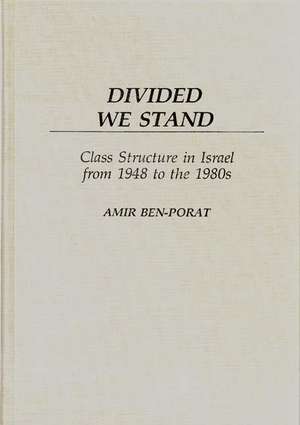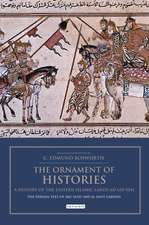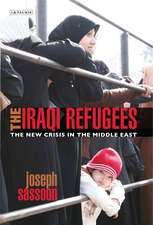Divided We Stand: Class Structure in Israel from 1948 to the 1980s: Contributions in Political Science, cartea 85
Autor Amir Ben-Poraten Limba Engleză Hardback – 31 oct 1989
Four decades of statehood for Israel has meant four decades of nationalistic, cultural, and ethnic conflicts. Throughout these growing pains, Israel has experienced a remarkable lack of class struggle unusually so during the transition to a capitalistic society. "Divided We Stand" shows that the lack of class struggle is no accident; it is a result of political design and necessity. In Israel, the state has been the predominating social agent and has therefore been in a position to supervise class struggle within the boundaries of its own rules. With an in-depth look at the class system and the lack of class struggle, this book provides an interesting perspective and analysis of Israeli society. This well-written book makes a strong contribution to the understanding of the nature and the patterns of social inequality in Israel. "Choice"
"Divided We Stand" monitors the development of class structure in Israel from 1948 to the mid-1980s by using information on the economy and on individuals' positions in the economy (gathered by the Israeli Central Bureau of Statistics). Numerous tables complement the written content by examining certain variables--such as immigration, gender, ethnic origin, mobility, types of industry and religion--over three decades. This book also analyzes the structural transformation of the society and explores the process of allocation and reallocation of Israeli citizens. "Divided We Stand" can be a practical, informative source for academics and students of sociology, political development, and Middle East affairs. As Israel continues to define itself, the book can serve as a useful guide and study to one of the more unexplored aspects of Israeli society.
Din seria Contributions in Political Science
- 35%
 Preț: 460.51 lei
Preț: 460.51 lei - 51%
 Preț: 300.97 lei
Preț: 300.97 lei - 23%
 Preț: 171.48 lei
Preț: 171.48 lei - 24%
 Preț: 464.24 lei
Preț: 464.24 lei - 33%
 Preț: 320.60 lei
Preț: 320.60 lei - 38%
 Preț: 439.77 lei
Preț: 439.77 lei - 27%
 Preț: 439.01 lei
Preț: 439.01 lei - 24%
 Preț: 465.40 lei
Preț: 465.40 lei - 38%
 Preț: 442.13 lei
Preț: 442.13 lei - 43%
 Preț: 297.08 lei
Preț: 297.08 lei - 38%
 Preț: 439.51 lei
Preț: 439.51 lei - 41%
 Preț: 328.13 lei
Preț: 328.13 lei - 42%
 Preț: 302.78 lei
Preț: 302.78 lei - 53%
 Preț: 381.77 lei
Preț: 381.77 lei - 38%
 Preț: 440.61 lei
Preț: 440.61 lei - 53%
 Preț: 367.93 lei
Preț: 367.93 lei - 42%
 Preț: 269.23 lei
Preț: 269.23 lei - 51%
 Preț: 304.19 lei
Preț: 304.19 lei - 52%
 Preț: 247.18 lei
Preț: 247.18 lei - 42%
 Preț: 321.02 lei
Preț: 321.02 lei - 43%
 Preț: 414.79 lei
Preț: 414.79 lei - 33%
 Preț: 321.44 lei
Preț: 321.44 lei - 52%
 Preț: 248.87 lei
Preț: 248.87 lei - 28%
 Preț: 362.62 lei
Preț: 362.62 lei - 23%
 Preț: 471.57 lei
Preț: 471.57 lei - 33%
 Preț: 320.31 lei
Preț: 320.31 lei - 34%
 Preț: 368.07 lei
Preț: 368.07 lei - 38%
 Preț: 206.27 lei
Preț: 206.27 lei - 38%
 Preț: 437.47 lei
Preț: 437.47 lei - 38%
 Preț: 438.00 lei
Preț: 438.00 lei - 38%
 Preț: 437.31 lei
Preț: 437.31 lei - 38%
 Preț: 345.49 lei
Preț: 345.49 lei - 38%
 Preț: 437.31 lei
Preț: 437.31 lei - 38%
 Preț: 436.99 lei
Preț: 436.99 lei - 38%
 Preț: 346.67 lei
Preț: 346.67 lei - 50%
 Preț: 305.89 lei
Preț: 305.89 lei - 38%
 Preț: 442.73 lei
Preț: 442.73 lei - 42%
 Preț: 252.57 lei
Preț: 252.57 lei - 38%
 Preț: 345.74 lei
Preț: 345.74 lei - 31%
 Preț: 284.72 lei
Preț: 284.72 lei - 27%
 Preț: 440.03 lei
Preț: 440.03 lei - 55%
 Preț: 150.08 lei
Preț: 150.08 lei - 31%
 Preț: 436.80 lei
Preț: 436.80 lei - 33%
 Preț: 321.35 lei
Preț: 321.35 lei - 38%
 Preț: 437.40 lei
Preț: 437.40 lei - 14%
 Preț: 355.15 lei
Preț: 355.15 lei - 28%
 Preț: 374.56 lei
Preț: 374.56 lei - 27%
 Preț: 364.06 lei
Preț: 364.06 lei - 42%
 Preț: 252.00 lei
Preț: 252.00 lei - 27%
 Preț: 438.41 lei
Preț: 438.41 lei
Preț: 345.30 lei
Preț vechi: 556.08 lei
-38% Nou
66.08€ • 71.75$ • 55.51£
Carte tipărită la comandă
Livrare economică 22 aprilie-06 mai
Specificații
ISBN-10: 0313264023
Pagini: 157
Dimensiuni: 156 x 248 x 17 mm
Greutate: 0.43 kg
Ediția:New.
Editura: Praeger
Seria Contributions in Political Science
Descriere
Cuprins
Israel after Statehood: An Overview
The Present Mattter: Class Model and Data
The Portrait of Class Structure
Becoming a Class Member: The Process of Allocation
Reallocation: Up and Down in the Class Structure
Structural Transformation: Class and Sector
Class Structure in Israel: A Summary--The Visible Hand
Index
Recenzii
«Four decades of statehood for Israel has meant four decades of nationalistic, cultural, and ethnic conflicts. Throughout these growing pains, Israel has experienced a remarkable lack of class struggle, unusual for a country during the transition to a capitalistic society. Divided We Stand shows that this lack of class struggle is no accident; it is the result of political design and necessity. In Israel, the state has been the predominating social agent and has therefore been in a position to supervise class struggle within the boundaries of its own rules.“”Shofar















